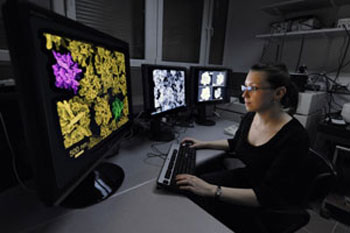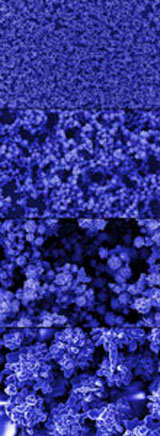| Jun 29, 2011 | |
Gold microflowers to enhance signals from molecules |
|
| (Nanowerk News) Researchers have to place objects under study on suitable substrates to obtain a strong enhancement of electromagnetic radiation emitted by single molecules. A simple and cheap method to fabricate substrates for SERS spectroscopy has been discovered at the Institute of Physical Chemistry of the Polish Academy of Sciences. A key role in substrate fabrication play spherical gold aggregates – flower-like micrometer-sized spheres. | |
| Surface Enhanced Raman Spectroscopy (SERS) is a promising research tool that allows to enhance signals emitted by molecules by hundreds of thousands or even millions of times. "There is, however, no joy without annoy", says Dr Marcin Fialkowski, associate professor at the Institute of Physical Chemistry of the Polish Academy of Sciences (IPC PAS). "To reach so high enhancement, the molecules must be placed on an appropriately shaped substrate. Under electron microscope, such substrates resemble peaked mountains, like Alps for example. The difference is that here the peak heights are measured in nanometres, and the mountains are covered not with snow but with a layer of gold". | |
 |
|
| Katarzyna Winkler, a PhD student from the Institute of Physical Chemistry of the Polish Academy of Sciences reviews electron microscope images showing substrates fabricated with gold microflowers. | |
| At present no cheap, good and easy-to-use substrates for SERS analyses are available on the market and this is one of the factors inhibiting commercialization of the method. A promising solution to the problem seem to offer substrates developed recently at the Institute of Physical Chemistry of the PAS under the research project "Quantum nanostructures". The substrates are fabricated by depositing spherical, strongly ragged gold structures precipitating from solution, on a slide surface. When observed under electron microscope, these micrometer-sized spheres resemble flower buds composed of many gold petals. | |
 Electron microscope images showing substrates made of microflowers. Magnification from top: 1000x, 5000x, 10000x, 30000x. The highest enhancement of a SERS signal is obtained when a molecule is placed in the meeting area of two "peaks" of the substrate. The effect can be hardly reached with existing mountain-like surfaces, as the peaks there are distinctly separated. The situation on the substrates made with gold flowers is different. "When ragged microflowers are deposited on the surface, they form thick, complex 3D structures with numerous meeting areas between the petals. That's why the signals emitted from our substrates are enhanced even by ten million times", stresses Katarzyna Winkler, a PhD student from the IPC PAS. Equally crucial as the enhancement is the repeatability of signals obtained from a specific substrate. In that respect the layers of gold microflowers show excellent performance. The signals originating from molecules of the same type that are placed at different locations on the same substrate are very similar to each other, and this is not always the case for surfaces obtained with other methods. High signal repeatability has also been observed for substrates fabricated on various slides, using separately prepared solutions. The fabrication of substrates using gold flowers is fast, simple and cheap, does not require to use neither robots nor clean rooms. "The reaction mixture contains only a gold salt and a reducing agent, mixed in an appropriate mixing ratio. The role of the reducing agent is to reduce gold cations to metallic gold", says Winkler. What remains is to immerse a roughened slide in so prepared solution. The deposition of gold flowers is usually completed within one hour, and the substrate is ready for use on the next day. The method of covering surfaces with gold microflowers designed for SERS applications has been filed for patenting. The present goal of the researchers from the Institute of Physical Chemistry of the PAS is to develop substrates that can be used repeatedly in measurements involving various analytes. For that purpose, methods to wash out analytes while leaving the substrate structure intact are being developed. |
| Source: Institute of Physical Chemistry of the Polish Academy of Sciences |
